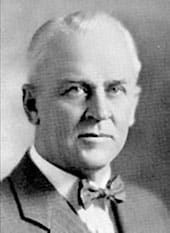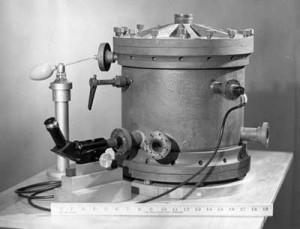In 1909 Robert Andrew Millikan set up an apparatus to measure the charge of an electron within an accuracy range of 3%. In 1913  he came out with a value of the electrical charge that would serve the world of science for a generation.
he came out with a value of the electrical charge that would serve the world of science for a generation.
Young Millikan had a childhood like most others: he had no idea what his profession would be. Once he recalled trying to jump from a rowboat to a dock, falling in the water, and almost drowning. Here he had his first account with physics – Newton’s Third Law of Motion: “For every action there is an equal and opposite reaction”. Even in High School Physics courses Millikan was not so spirited, which may have had a little to do with his teacher’s habit of spending the summers using a divining rod to find water. After Millikan graduated from Maquoketa High he was accepted into Oberlin College. Robert actually began his physics career when he taught an elementary course at the request of his Greek professor during his sophomore year. He then transferred to Columbia University from which he graduated in 1893 as the only student graduate in physics. After this accomplishment Millikan travelled to Germany to study with such professors Planck and others. When this period was on his resume Millikan was offered a position in the Physics department at the University of Chicago and Millikan took it. After teaching for a period Millikan decided that physics could only be taught properly through the practice of experimentation and getting your hands in it just as many other things are. Thus, he began writing better textbooks for the University of Chicago, “In fact he spent the morning of his wedding day reading proofs of his textbooks” ( http://physics.uwstout.edu/sotw/millikan.html )
During his 12 hours of teaching each day Millikan spent half of his time doing research. In 1909 he constructed his first oil drop apparatus to determine the charge of an electron. Millikan discovered that the charge depended on the frequency of incident light. In the beginning of his experimentation Millikan was using a drop of water. Using a water drop only gave Millikan forty five seconds  in which to measure the charge, due to the volatility of the water. Millikan then switched to using a drop of oil because of its low volatility and as a result was allowed four and one half hours to measure the charge.
in which to measure the charge, due to the volatility of the water. Millikan then switched to using a drop of oil because of its low volatility and as a result was allowed four and one half hours to measure the charge.
In 1909 Millikan figured he was within 2% of being accurate. In 1910 Millikan actually announced numerical value for this fundamental atomic constant, 4.891×10-10 esu. [After Millikan announced this number he was elected Vice Chairman and Director of Research for the National Research Council in 1917.] Millikan realized there were inaccuracies when then photocurrent near the cutoff point was too low to measure. Noticing that the current was highest when the metal was fresh Millikan fashioned his targets into thick cylinders and rigged up an electro-magnetically controlled knife to shave off the ends of the blocks.
Millikan went on to the Physics Laboratory at California Institute of Technology, where he obtained his Doctorate and stayed on doing research on Cosmic Rays until he retired in 1945. It was while he was at Cal Tech in 1923 that he won the Nobel Prize in Physics. Millikan was the first Cal Tech Doctorate to achieve a Nobel Prize.
